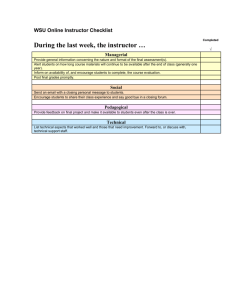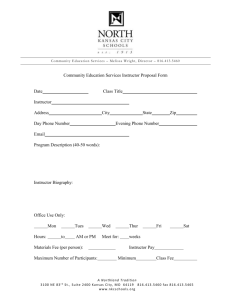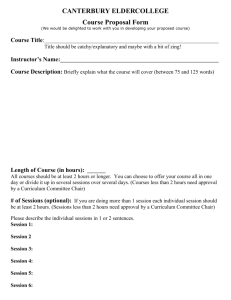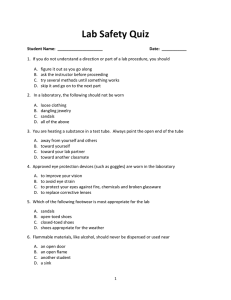General Laboratory and Safety Rules
advertisement
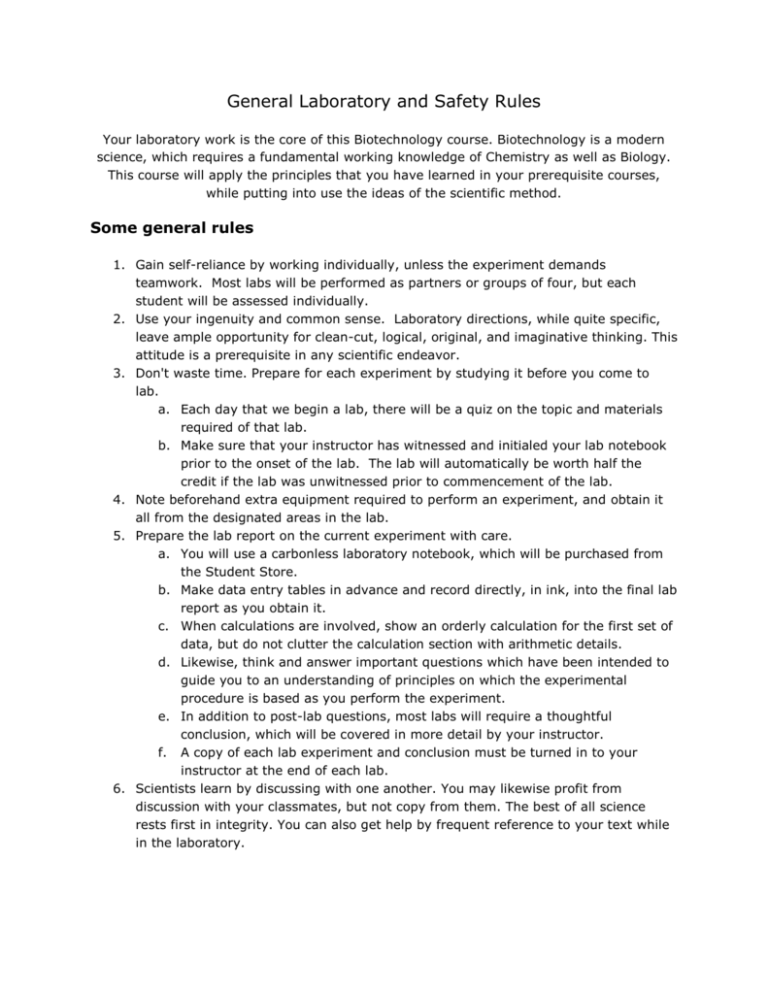
General Laboratory and Safety Rules Your laboratory work is the core of this Biotechnology course. Biotechnology is a modern science, which requires a fundamental working knowledge of Chemistry as well as Biology. This course will apply the principles that you have learned in your prerequisite courses, while putting into use the ideas of the scientific method. Some general rules 1. Gain self-reliance by working individually, unless the experiment demands teamwork. Most labs will be performed as partners or groups of four, but each student will be assessed individually. 2. Use your ingenuity and common sense. Laboratory directions, while quite specific, leave ample opportunity for clean-cut, logical, original, and imaginative thinking. This attitude is a prerequisite in any scientific endeavor. 3. Don't waste time. Prepare for each experiment by studying it before you come to lab. a. Each day that we begin a lab, there will be a quiz on the topic and materials required of that lab. b. Make sure that your instructor has witnessed and initialed your lab notebook prior to the onset of the lab. The lab will automatically be worth half the credit if the lab was unwitnessed prior to commencement of the lab. 4. Note beforehand extra equipment required to perform an experiment, and obtain it all from the designated areas in the lab. 5. Prepare the lab report on the current experiment with care. a. You will use a carbonless laboratory notebook, which will be purchased from the Student Store. b. Make data entry tables in advance and record directly, in ink, into the final lab report as you obtain it. c. When calculations are involved, show an orderly calculation for the first set of data, but do not clutter the calculation section with arithmetic details. d. Likewise, think and answer important questions which have been intended to guide you to an understanding of principles on which the experimental procedure is based as you perform the experiment. e. In addition to post-lab questions, most labs will require a thoughtful conclusion, which will be covered in more detail by your instructor. f. A copy of each lab experiment and conclusion must be turned in to your instructor at the end of each lab. 6. Scientists learn by discussing with one another. You may likewise profit from discussion with your classmates, but not copy from them. The best of all science rests first in integrity. You can also get help by frequent reference to your text while in the laboratory. Laboratory rules 1. Maintain an orderly, clean laboratory bench. Invert glassware over a paper towel to dry. Clean your area with a thorough wash and wipe of the desk top at the close of the period. 2. Discard solids into the appropriate waste containers. If you have a question as to the disposal method of any material in the lab, be sure to ask the instructor or TA for directions. 3. Leave stock solutions at the stock table. Bring test tubes or beakers to the shelf for transferring chemicals and carrying them to your desk. 4. Read the label twice before taking anything from a bottle. 5. Avoid using excessive amount of reagent - 2 or 3 mL is usually ample for test tube reactions. 6. Never return unused chemicals to the stock bottle. You may make a mistake from which other students' experiments will suffer. 7. Do not insert your own pipets into the stock solution. Avoid contamination of the stock solution by pouring the solution from the bottle. 8. Do not lay the stopper of a bottle down. Impurities may be picked up and thus contaminate the solution when the stopper is returned. 9. Do not heat heavy glassware such as graduated cylinders, or bottles; they break easily. Test tubes may break if they are heated above the liquid level and liquid is then splashed over the hot glass. 10. Keep your lab bench drawers clean and locked. This will keep unwanted hands out of your drawer, and will ensure that you will receive full credit on random periodic lab drawer checks performed by your instructor. Safety Precautions 1. Maintain a wholesome, businesslike attitude at all times. For the safety of the whole class, unauthorized experiments are prohibited. 2. Know the location and operation of the eye wash, fire extinguisher, fire blanket, and safety shower. 3. Always wear safety goggles! Wear protective goggles at all times in the laboratory, as directed by your instructor. Flush corrosive liquid from the eye with plenty of water using the eye wash fountain for a full 15 minutes. It is recommended that contacts not be worn in the laboratory. 4. Avoid direct contact with chemicals! If corrosive liquids touch the skin, flood with water. Consult your instructor immediately. 5. Do not point your test tube at your neighbor or yourself when heating substances. A suddenly formed bubble of vapor may eject the contents violently. 6. Do not hold your face directly over a container when noting the odor. Instead, fan a little of the vapor toward your nostrils by sweeping your hand over the top of the container. 7. No food or drink allowed in the laboratory. Do not put anything in your mouth until you have washed your hands and left the room. Never taste a chemical or solution in the lab. (Poisonous substances are not always clearly labeled in the laboratory.) 8. Use the hood for reactions involving poisonous or noxious gases. It is a device that provides suction to remove such gases or vapors. 9. Protective clothing must be worn when working in the laboratory. If clothing that exposes bare skin is worn, then a laboratory apron or laboratory coat is required. Sandals and open-toed shoes are not allowed in the laboratory. 10. Report even minor injuries to your instructor at once.




